Submitted:
22 August 2024
Posted:
22 August 2024
You are already at the latest version
Abstract
Keywords:
1. Introduction
2. PV Modeling Method
2.1. Triple-Diode PV Module Model
2.2. Problem Formulation
3. DEIMA Optimization Algorithm
3.1. Initialization
3.2. Mutation
3.3. Crossover
3.4. Selection
4. Evaluation Criteria
4.1. Root Mean Square Error ()
4.2. Mean Bias Error ()
4.3. Coefficient of Determination ()
4.4. Average Absolute Error ()
4.5. Deviation of RMSE ()
4.6. Standard Test Deviation ()
4.7. CPU-Execution Time (CET)
5. Results and Discussion
6. Conclusion
Author Contributions
Funding
Data Availability Statement
Acknowledgments
Declaration of competing interest
References
- Mustafa Ibrahim Mansoor, and Haider Tarish Haider, "A multi-objective residential load management based on self-adapting differential evolution", Renewable Energy Focus, Volume 38, (2021). 44-56. [CrossRef]
- Kharchouf, Youssef, Rachid Herbazi, and Adil Chahboun. "Parameter’s extraction of solar photovoltaic models using an improved differential evolution algorithm." Energy Conversion and Management 251 (2022): 114972. [CrossRef]
- Fan, Yi, Pengjun Wang, Ali Asghar Heidari, Huiling Chen, and Majdi Mafarja. "Random reselection particle swarm optimization for optimal design of solar photovoltaic modules." Energy 239 (2022): 121865. [CrossRef]
- Rigo, Paula D., Julio Cezar M. Siluk, Daniel P. Lacerda, and Júlia P. Spellmeier. "Competitive business model of photovoltaic solar energy installers in Brazil." Renewable Energy 181 (2022): 39-50. [CrossRef]
- Ridha, Hussein Mohammed, Hashim Hizam, Chandima Gomes, Ali Asghar Heidari, Huiling Chen, Masoud Ahmadipour, Dhiaa Halboot Muhsen, and Mokhalad Alghrairi. "Parameters extraction of three diode photovoltaic models using boosted LSHADE algorithm and Newton Raphson method." Energy 224 (2021): 120136. [CrossRef]
- Farah, Anouar, Akram Belazi, Feres Benabdallah, Abdulaziz Almalaq, Mohamed Chtourou, and M. A. Abido. "Parameter extraction of photovoltaic models using a comprehensive learning Rao-1 algorithm." Energy Conversion and Management 252 (2022): 115057. [CrossRef]
- Lappalainen, Kari, Michel Piliougine, and Giovanni Spagnuolo. "Experimental comparison between various fitting approaches based on RMSE minimization for photovoltaic module parametric identification." Energy Conversion and Management 258 (2022): 115526. [CrossRef]
- Kalliojärvi-Viljakainen, Heidi, Kari Lappalainen, and Seppo Valkealahti. "A novel procedure for identifying the parameters of the single-diode model and the operating conditions of a photovoltaic module from measured current–voltage curves." Energy Reports 8 (2022): 4633-4640. [CrossRef]
- Gude, Srihari, Kartick Chandra Jana, Antonino Laudani, and Sudhakar Babu Thanikanti. "Parameter extraction of photovoltaic cell based on a multi-objective approach using nondominated sorting cuckoo search optimization." Solar Energy 239 (2022): 359-374. [CrossRef]
- E. E. Kalu, Numerical Methods with Applications: Abridged: Lulu. com, 2008.
- R. Navabi, S. Abedi, S. H. Hosseinian, and R. Pal, "On the fast convergence modeling and accurate calculation of PV output energy for operation and planning studies," Energy Conversion and Management, vol. 89, pp. 497-506, 1/1/ 2015. [CrossRef]
- S. Lineykin, M. Averbukh, and A. Kuperman, "An improved approach to extract the single-diode equivalent circuit parameters of a photovoltaic cell/panel," Renewable and Sustainable Energy Reviews, vol. 30, pp. 282-289, 2// 2014. [CrossRef]
- M. Hejri, H. Mokhtari, M. R. Azizian, M. Ghandhari, and L. Soder, "On the Parameter Extraction of a Five-Parameter Double-Diode Model of Photovoltaic Cells and Modules," Photovoltaics, IEEE Journal of, vol. 4, pp. 915-923, 2014. [CrossRef]
- M. Karamirad, M. Omid, R. Alimardani, H. Mousazadeh, and S. N. Heidari, "ANN based simulation and experimental verification of analytical four- and five-parameters models of PV modules," Simulation Modelling Practice and Theory, vol. 34, pp. 86-98, 5// 2013. [CrossRef]
- Ram, J. Prasanth, Dhanup S. Pillai, Derick Mathew, Jihun Ha, and Young-Jin Kim. "A simple, reliable and adaptive approach to estimate photovoltaic parameters using spotted hyena optimization: A framework intelligent to predict photovoltaic parameters for any meteorological change." Solar Energy 236 (2022): 480-498. [CrossRef]
- Khanna, Vandana, B. K. Das, Dinesh Bisht, and P. K. Singh. "A three diode model for industrial solar cells and estimation of solar cell parameters using PSO algorithm." Renewable Energy 78 (2015): 105-113. [CrossRef]
- Qais, Mohammed H., Hany M. Hasanien, Saad Alghuwainem, and Adnan S. Nouh. "Coyote optimization algorithm for parameters extraction of three-diode photovoltaic models of photovoltaic modules." Energy 187 (2019): 116001. [CrossRef]
- Shankar, N., and N. Saravanakumar. "Solar photovoltaic module parameter estimation with an enhanced differential evolutionary algorithm using the manufacturer’s datasheet information." Optik 224 (2020): 165700. [CrossRef]
- Kumar, C., T. Dharma Raj, M. Premkumar, and T. Dhanesh Raj. "A new stochastic slime mould optimization algorithm for the estimation of solar photovoltaic cell parameters." Optik 223 (2020): 165277. [CrossRef]
- Qais, Mohammed H., Hany M. Hasanien, and Saad Alghuwainem. "Transient search optimization for electrical parameters estimation of photovoltaic module based on datasheet values." Energy Conversion and Management 214 (2020): 112904. [CrossRef]
- Yousri, Dalia, Mohamed Abd Elaziz, Diego Oliva, Laith Abualigah, Mohammed AA Al-Qaness, and Ahmed A. Ewees. "Reliable applied objective for identifying simple and detailed photovoltaic models using modern metaheuristics: Comparative study." Energy Conversion and Management 223 (2020): 113279. [CrossRef]
- Qais, Mohammed H., Hany M. Hasanien, and Saad Alghuwainem. "Parameters extraction of three-diode photovoltaic model using computation and Harris Hawks optimization." Energy 195 (2020): 117040. [CrossRef]
- Chenouard, Raphael, and Ragab A. El-Sehiemy. "An interval branch and bound global optimization algorithm for parameter estimation of three photovoltaic models." Energy Conversion and Management 205 (2020): 112400. [CrossRef]
- Ibrahim, Ibrahim Anwar, M. J. Hossain, Benjamin C. Duck, and Mithulananthan Nadarajah. "An improved wind driven optimization algorithm for parameters identification of a triple-diode photovoltaic cell model." Energy Conversion and Management 213 (2020): 112872. [CrossRef]
- Houssein, Essam H., Gamela Nageh Zaki, Ahmed A. Zaki Diab, and Eman MG Younis. "An efficient Manta Ray Foraging Optimization algorithm for parameter extraction of three-diode photovoltaic model." Computers & Electrical Engineering 94 (2021): 107304. [CrossRef]
- Ćalasan, Martin, Shady HE Abdel Aleem, and Ahmed F. Zobaa. "A new approach for parameters estimation of double and triple diode models of photovoltaic cells based on iterative Lambert W function." Solar Energy 218 (2021): 392-412. [CrossRef]
- Zhou, Wei, Pengjun Wang, Ali Asghar Heidari, Xuehua Zhao, Hamza Turabieh, Majdi Mafarja, and Huiling Chen. "Metaphor-free dynamic spherical evolution for parameter estimation of photovoltaic modules." Energy Reports 7 (2021): 5175-5202. [CrossRef]
- Wang, Da, Xingping Sun, Hongwei Kang, Yong Shen, and Qingyi Chen. "Heterogeneous differential evolution algorithm for parameter estimation of solar photovoltaic models." Energy Reports 8 (2022): 4724-4746. [CrossRef]
- El-Fergany, Attia A. "Parameters identification of PV model using improved slime mould optimizer and Lambert W-function." Energy Reports 7 (2021): 875-887. [CrossRef]
- D. H. Muhsen, A. B. Ghazali, T. Khatib, and I. A. Abed, “Parameters extraction of double diode photovoltaic module’s model based on hybrid evolutionary algorithm,” Energy Convers. Manag., vol. 105, pp. 552–561, 2015, doi: 10.1016/j.enconman.2015.08.023. [CrossRef]
- L. L. Jiang, D. L. Maskell, and J. C. Patra, “Parameter estimation of solar cells and modules using an improved adaptive differential evolution algorithm,” Appl. Energy, vol. 112, pp. 185–193, 2013, doi: 10.1016/j.apenergy.2013.06.004. [CrossRef]
- D. H. Muhsen, A. B. Ghazali, T. Khatib, and I. A. Abed, “Extraction of photovoltaic module model’s parameters using an improved hybrid differential evolution/electromagnetism-like algorithm,” Sol. Energy, vol. 119, pp. 286–297, Sep. 2015, doi: 10.1016/j.solener.2015.07.008. [CrossRef]
- K. Ishaque, Z. Salam, H. Taheri, and A. Shamsudin, "A critical evaluation of EA computational methods for Photovoltaic cell parameter extraction based on two diode model," Solar Energy, vol. 85, pp. 1768-1779, 9// 2011. [CrossRef]
- F. Vitaliy, "Differential evolution–in search of solutions," ed: Springer, New York, 2006.
- R. Benkercha, S. Moulahoum, and B. Taghezouit, “Extraction of the PV modules parameters with MPP estimation using the modified flower algorithm,” Renew. Energy, vol. 143, pp. 1698–1709, Dec. 2019, doi: 10.1016/j.renene.2019.05.107. [CrossRef]
- K. Ishaque, Z. Salam, S. Mekhilef, and A. Shamsudin, “Parameter extraction of solar photovoltaic modules using penalty-based differential evolution,” Appl. Energy, vol. 99, pp. 297–308, 2012, doi: 10.1016/j.apenergy.2012.05.017. [CrossRef]
- L. L. Jiang, D. L. Maskell, and J. C. Patra, “Parameter estimation of solar cells and modules using an improved adaptive differential evolution algorithm,” Appl. Energy, vol. 112, pp. 185–193, 2013, doi: 10.1016/j.apenergy.2013.06.004. [CrossRef]
- Ş. I. Birbil and S. C. Fang, “An electromagnetism-like mechanism for global optimization,” J. Glob. Optim., vol. 25, no. 3, pp. 263–282, 2003, doi: 10.1023/A:1022452626305. [CrossRef]
- Kanimozhi, G., and Harish Kumar. "Modeling of solar cell under different conditions by Ant Lion Optimizer with Lambert W function." Applied Soft Computing 71 (2018): 141-151. [CrossRef]
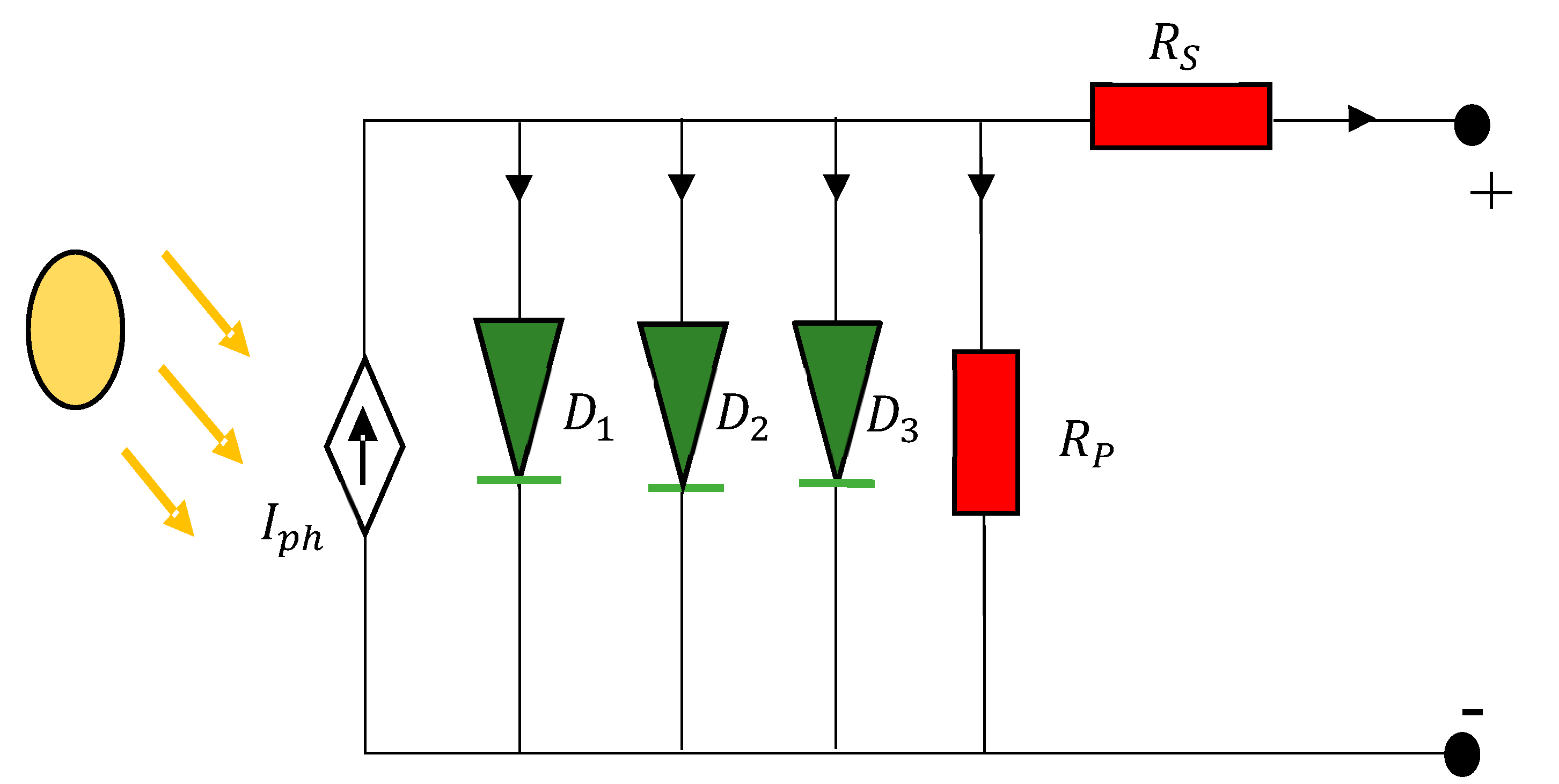
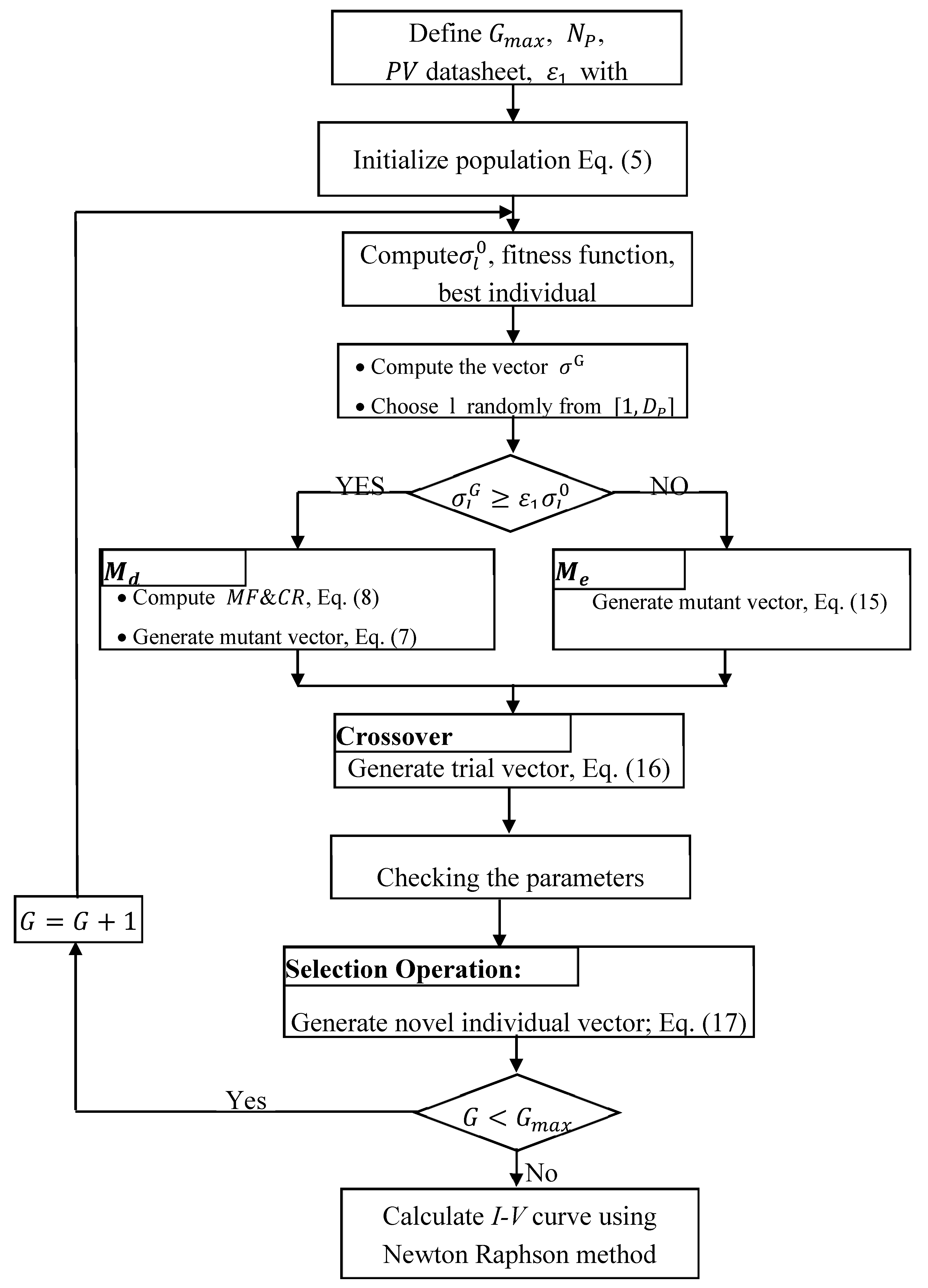
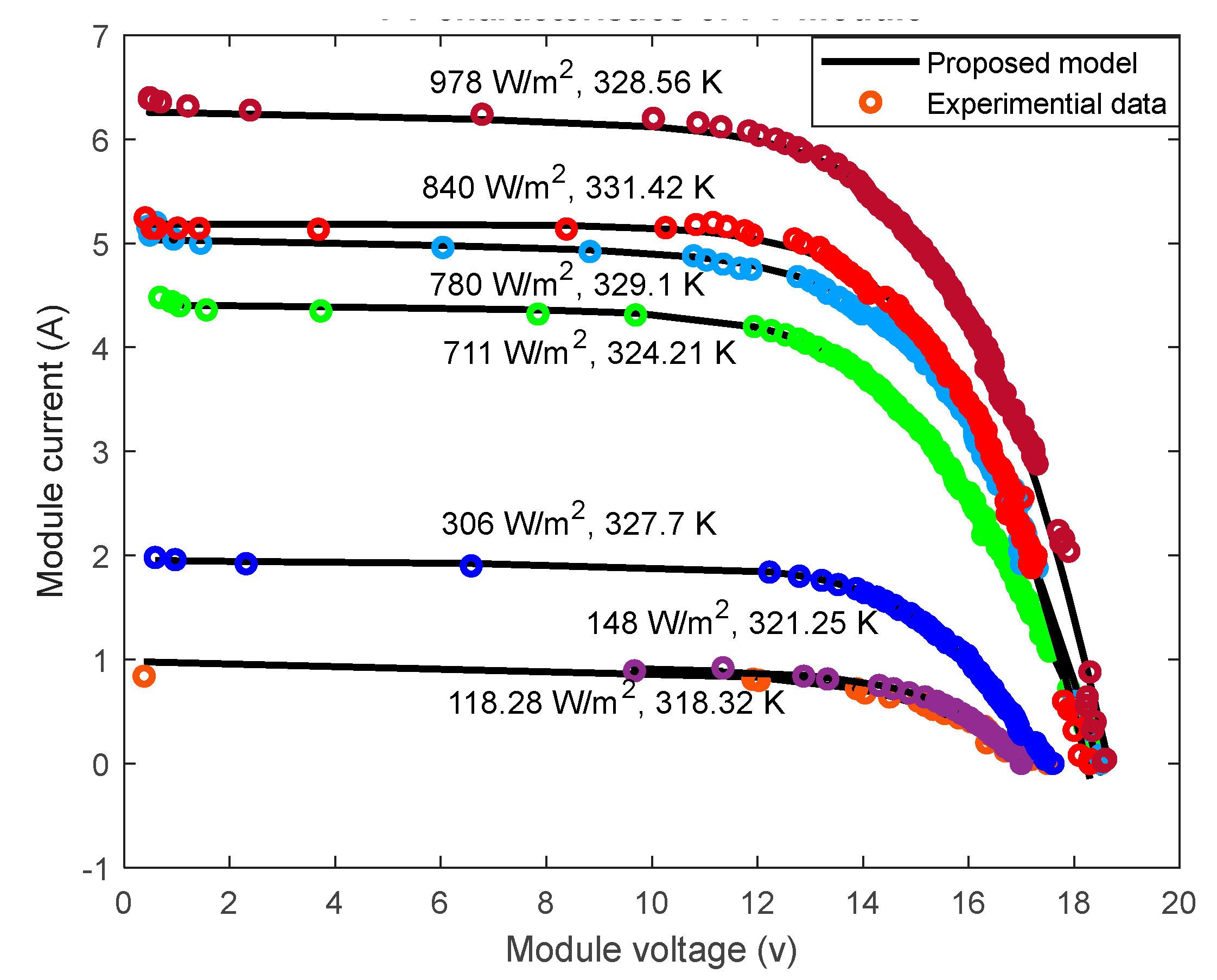
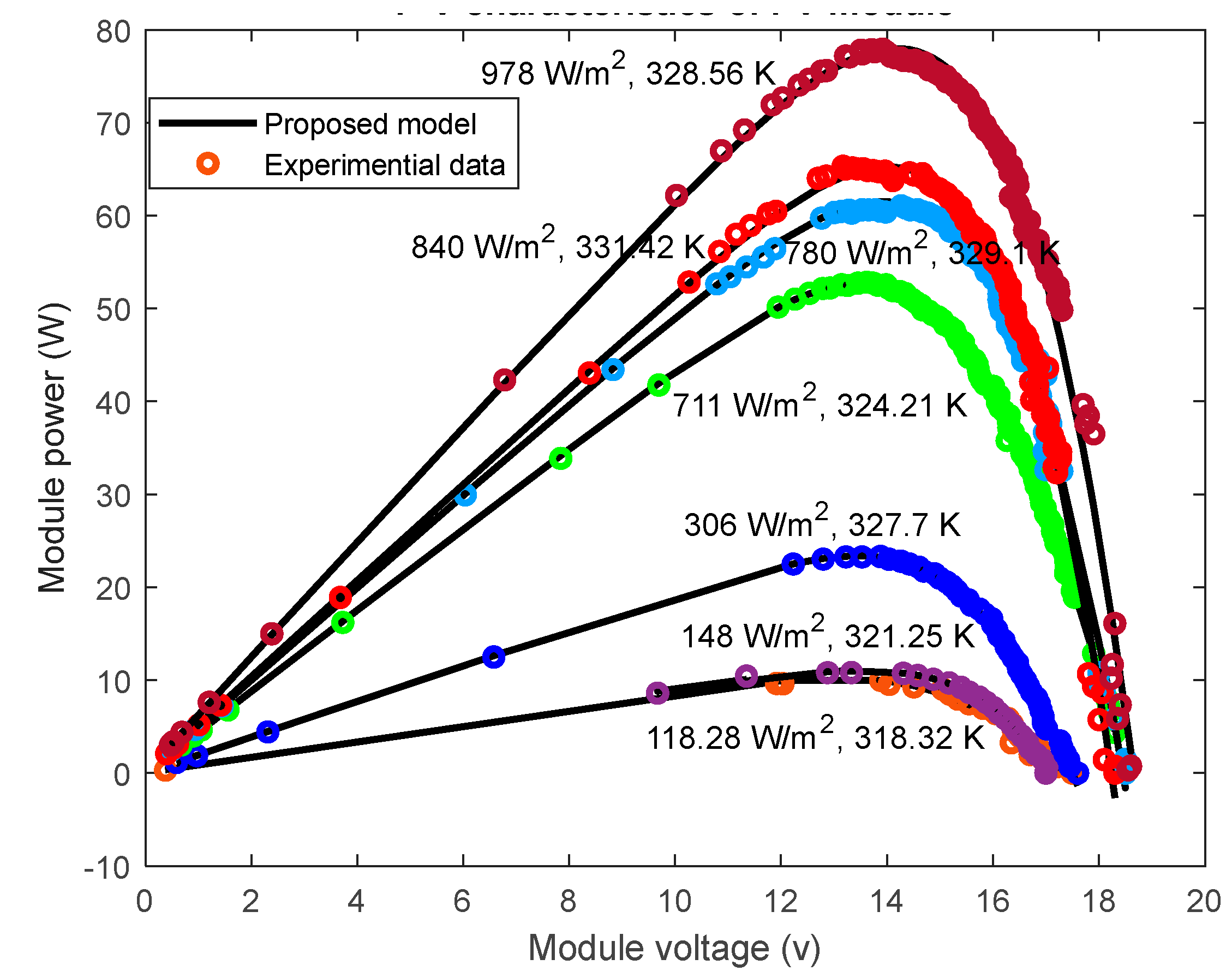
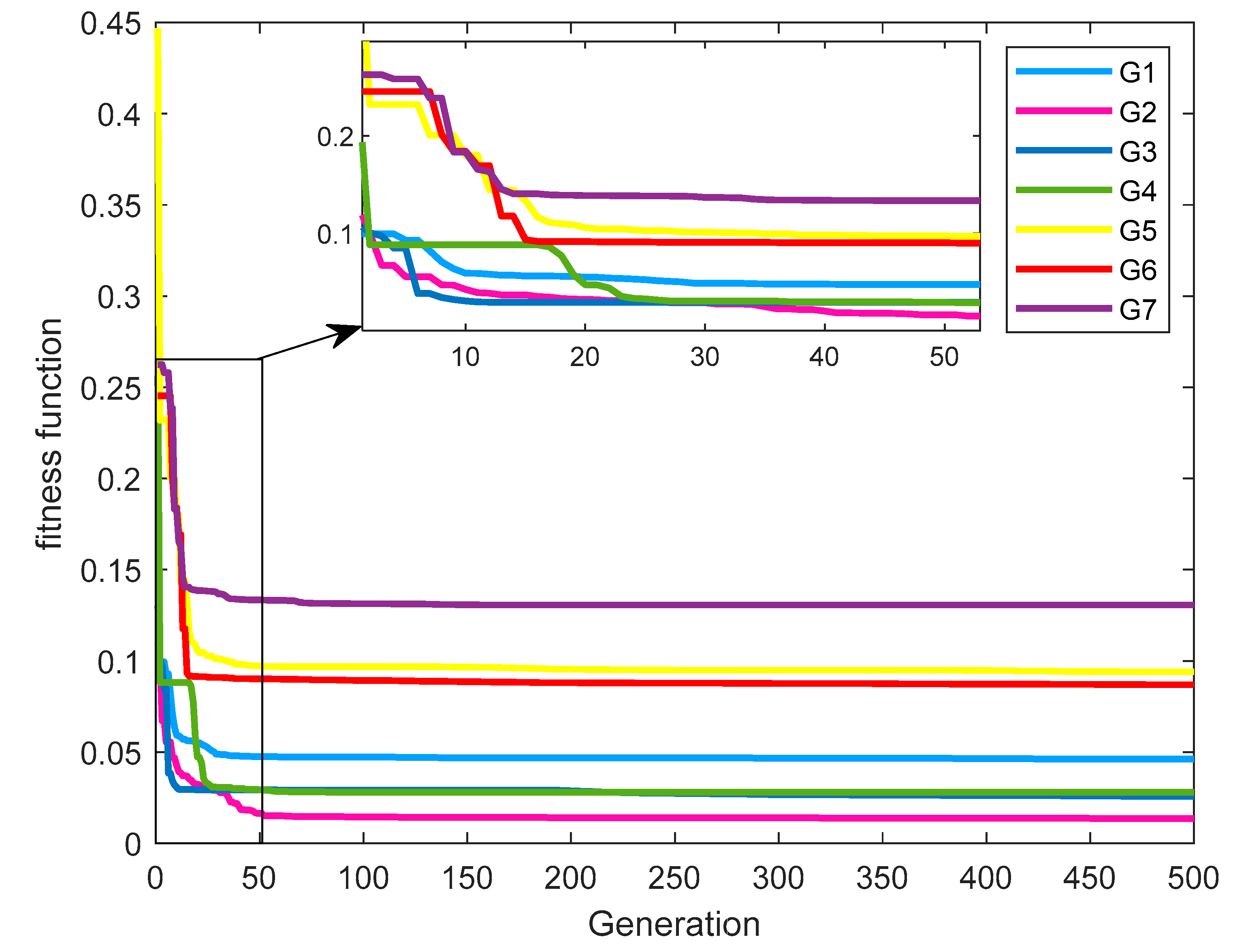
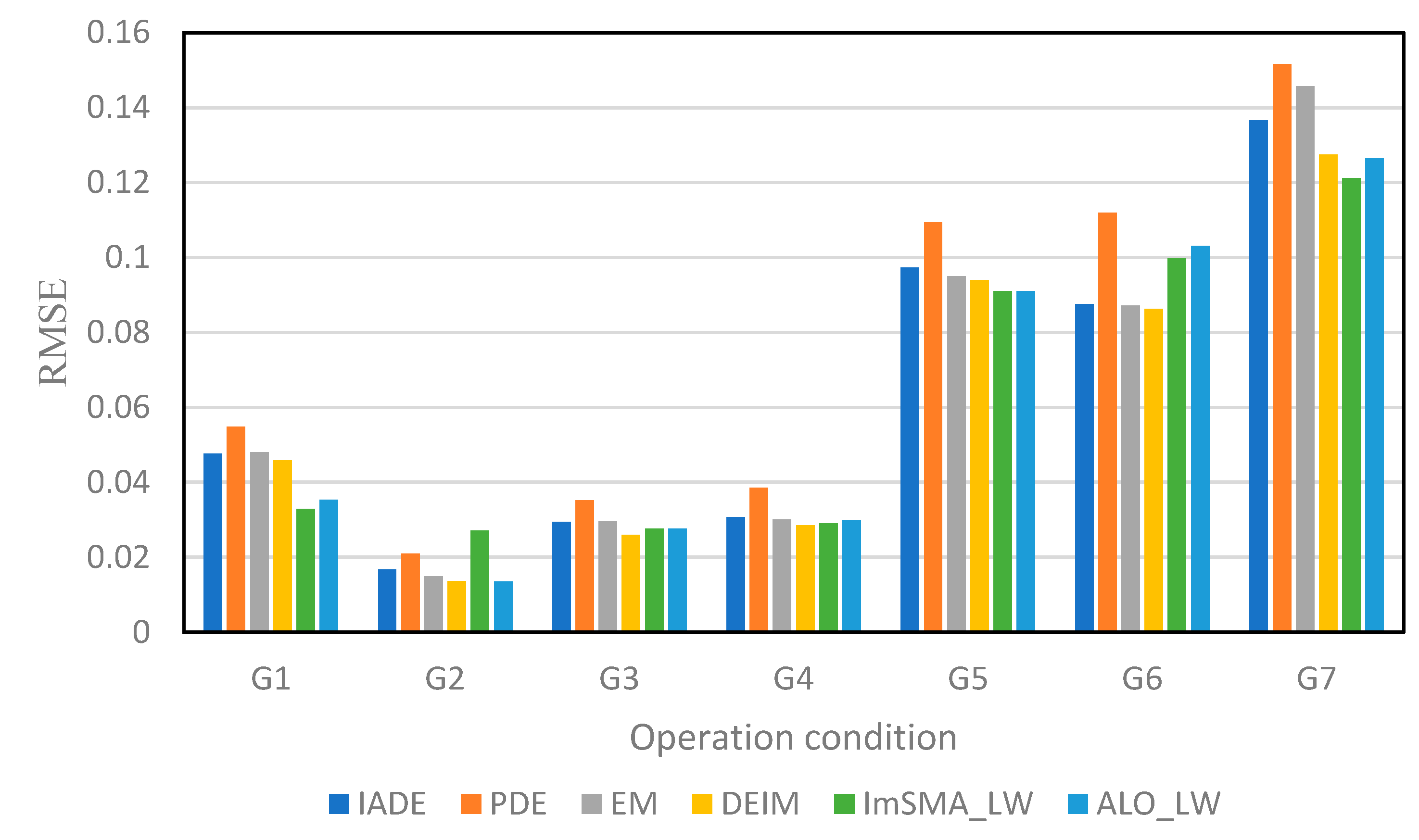
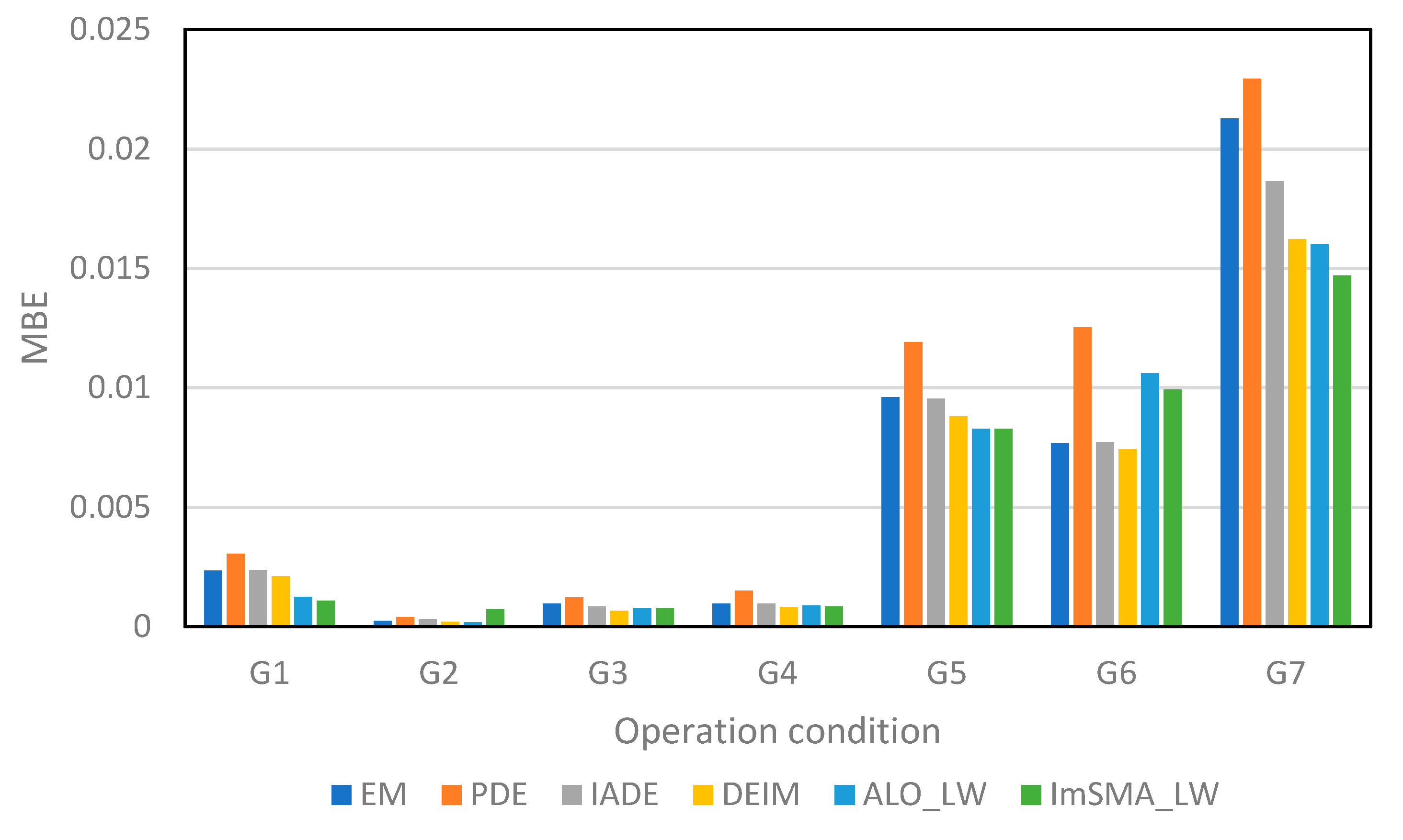
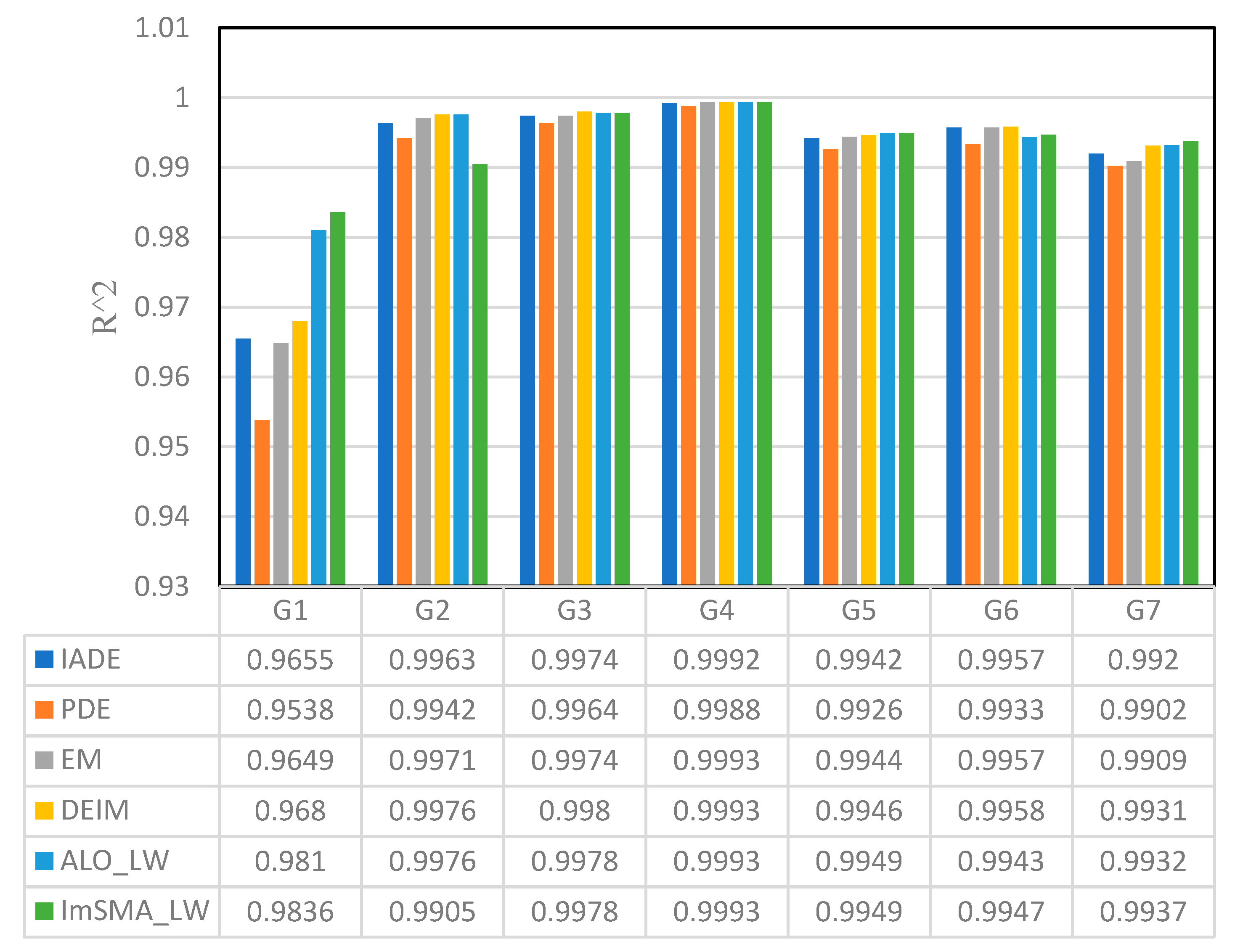
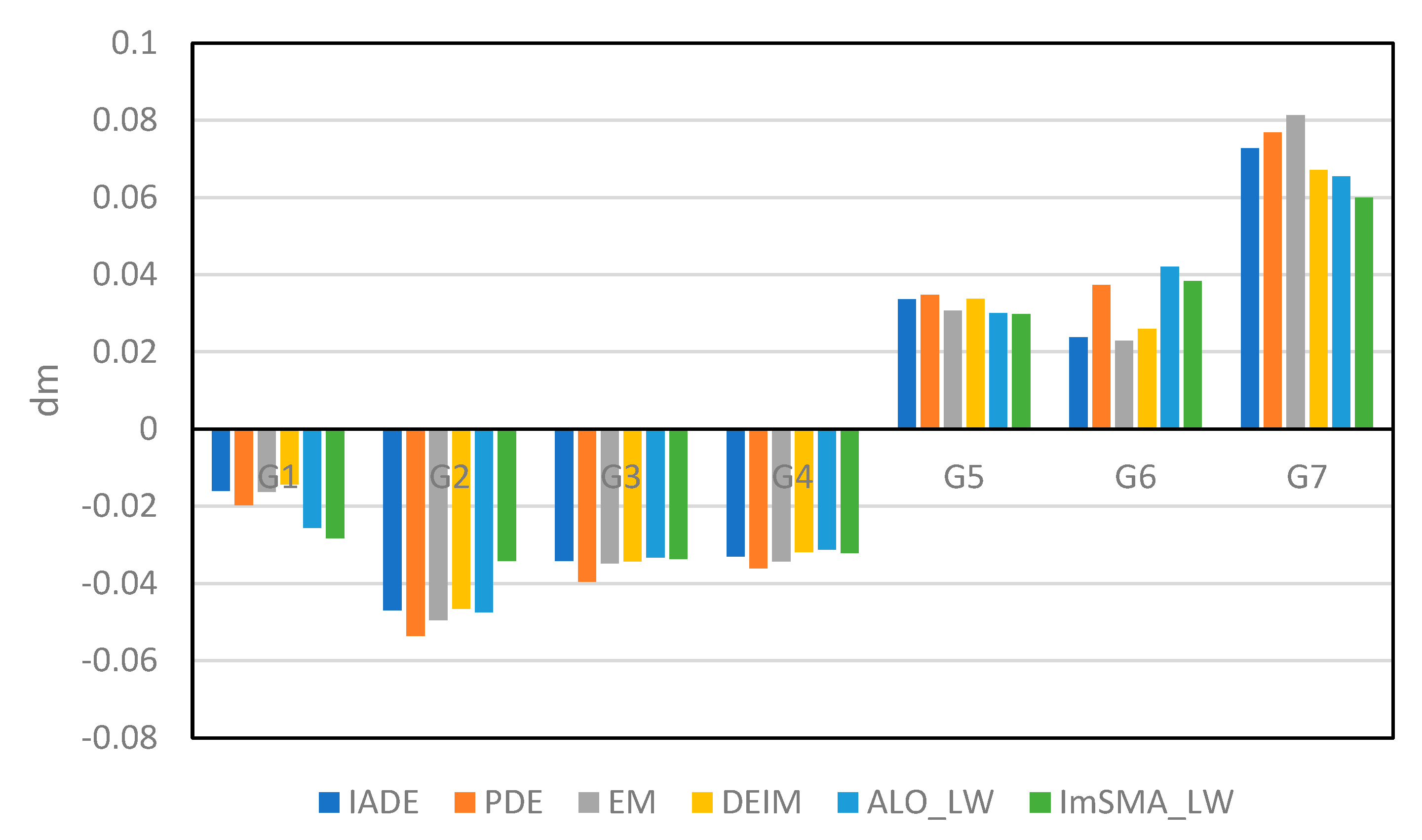
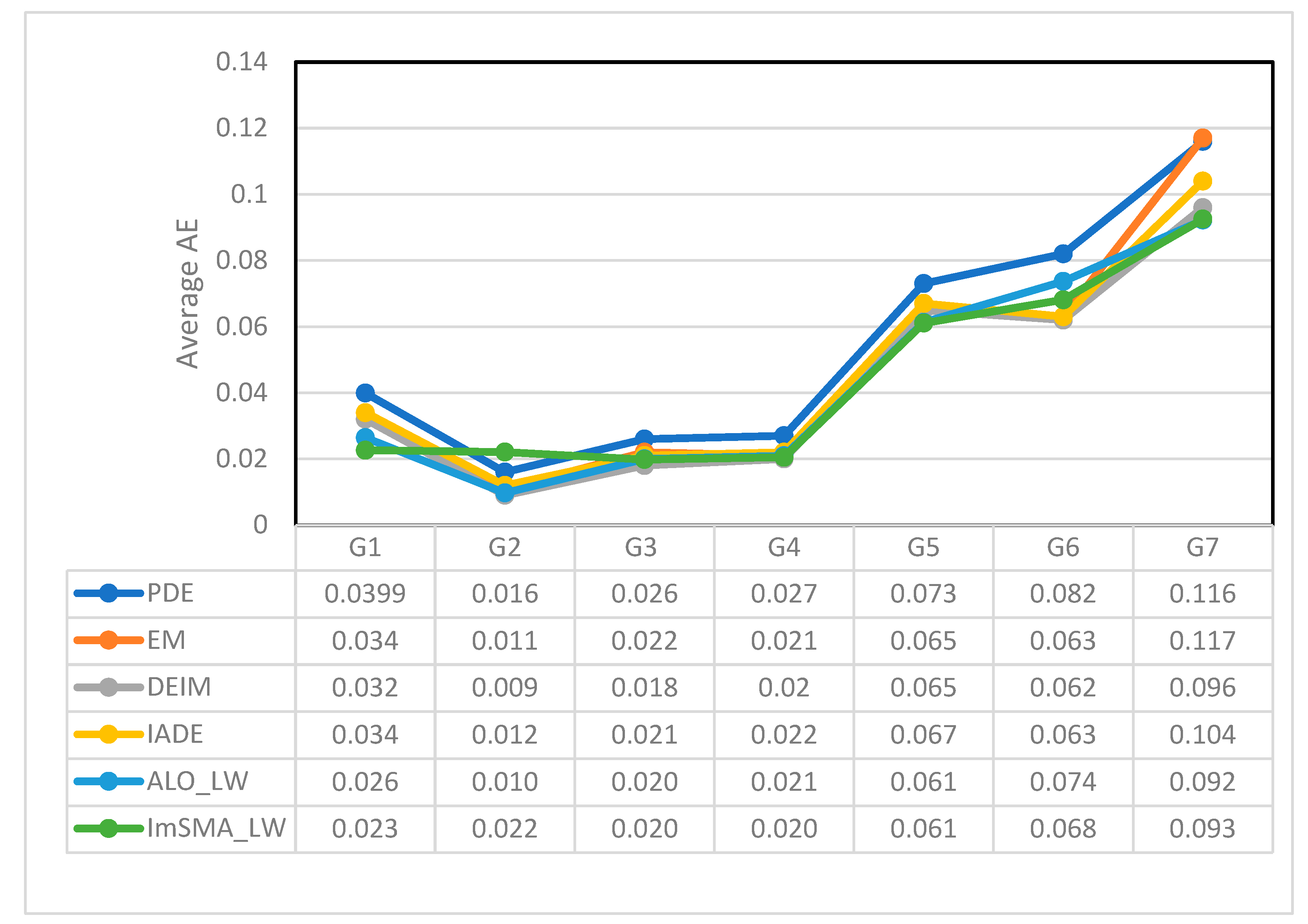
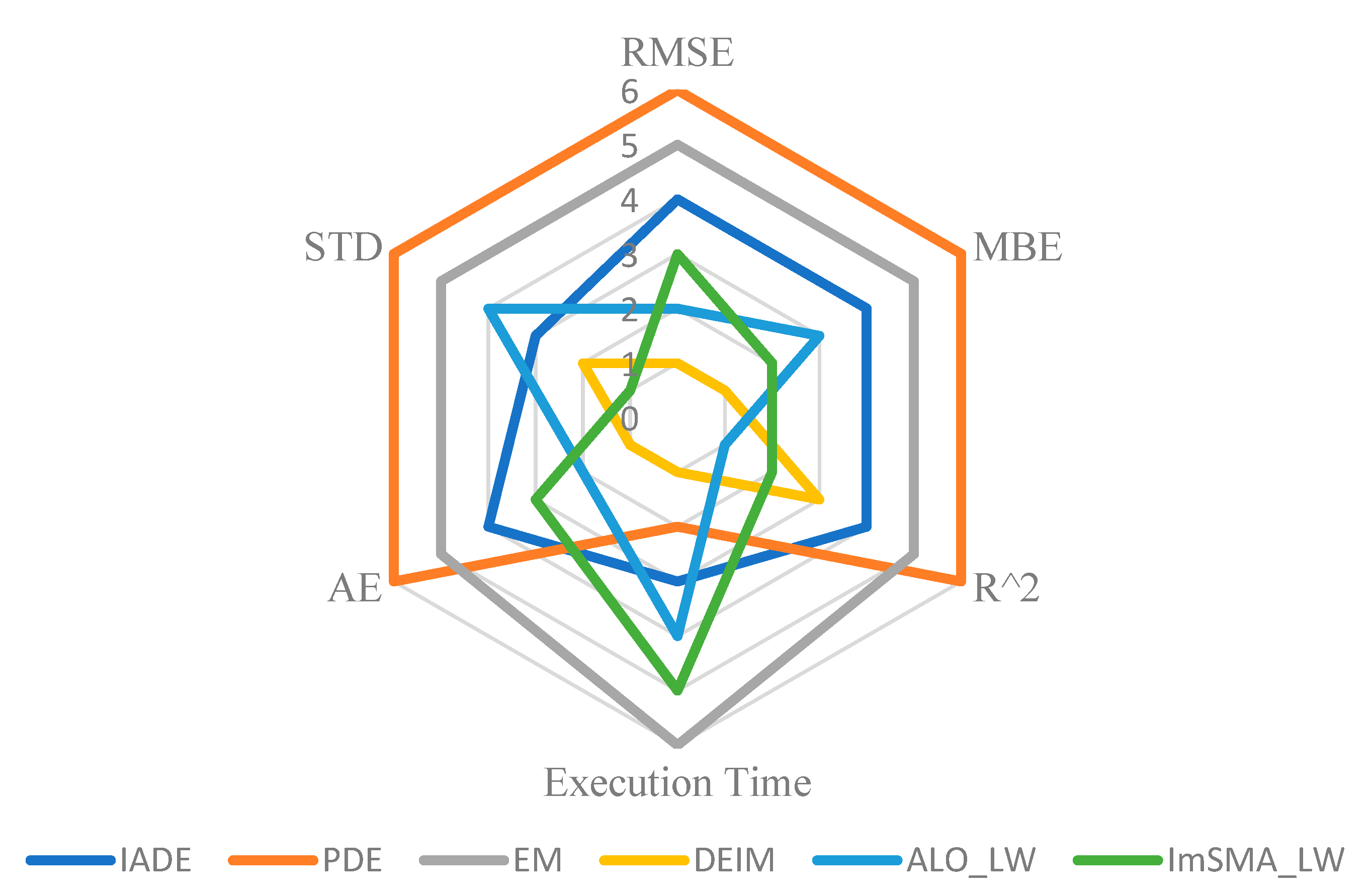
| Characteristics | Value |
|---|---|
| Number of cells connected in series | 36 |
| Short-circuit current () | 7.45 A |
| Open-circuit voltage () | 21.5 V |
| Current at maximum power point () | 7.1 A |
| Voltage at maximum power point () | 16.9 V |
| Maximum power at STC () | 120 WP |
| Temperature coefficient of () | 1.325 mA/K |
| Temperature coefficient of () | -77.5 mV/K |
| Weather condition | ) | Solar radiance (W/m2) | Cell temperature (K) |
|---|---|---|---|
| G1 | 22 | 118.28 | 318.32 |
| G2 | 24 | 148 | 321.25 |
| G3 | 50 | 306 | 327.7 |
| G4 | 91 | 711 | 324.21 |
| G5 | 92 | 780 | 329.1 |
| G6 | 101 | 840 | 331.42 |
| G7 | 102 | 978 | 328.56 |
| Parameter | G1 | G2 | G3 | G4 | G5 | G6 | G7 |
|---|---|---|---|---|---|---|---|
| 1.00004 | 1.40544 | 1.97468 | 1.99608 | 1.64065 | 1.53082 | 1.49762 | |
| 1.97660 | 1.45038 | 1.06383 | 1.00095 | 1.49554 | 1.44084 | 1.49754 | |
| 1.99144 | 1.35464 | 1.04220 | 1.31040 | 1.45000 | 1.45671 | 1.49766 | |
| 1.90299 | 0.13195 | 0.75172 | 0.53455 | 0.23549 | 0.16636 | 0.18106 | |
| 100.00554 | 125.38801 | 195.59178 | 169.22920 | 100.00108 | 4798.1068 | 100.00002 | |
| 1.00000 | 1.00000 | 1.95796 | 4.42801 | 5.05995 | 5.18610 | 6.27363 | |
| 1.59E-08 | 6.695E-10 | 8.974E-07 | 3.610E-06 | 9.966E-06 | 9.996E-06 | 1.00E-05 | |
| 9.97E-06 | 5.555E-06 | 2.591E-09 | 6.494E-09 | 9.948E-06 | 9.779E-06 | 1.00E-05 | |
| 9.96E-06 | 4.180E-07 | 1.232E-07 | 2.915E-06 | 9.692E-06 | 9.994E-06 | 1.00E-05 |
| Algorithm | Operation condition | Average | ||||||
|---|---|---|---|---|---|---|---|---|
| G1 | G2 | G3 | G4 | G5 | G6 | G7 | ||
| IADE | 30.16 | 28.25 | 27.5 | 30.063 | 30.031 | 30.75 | 31.25 | 29.71 |
| PDE | 32.8 | 29.78 | 27.13 | 29.58 | 31.33 | 28.02 | 28.11 | 29.54 |
| EM | 5152.51 | 5050.24 | 5623.41 | 6599.23 | 5811.21 | 5769.82 | 6487.71 | 5784.88 |
| DEIM | 24.94 | 26.50 | 26.56 | 28.75 | 28.69 | 29.19 | 29.20 | 27.69 |
| ALO_LW | 1827.64 | 553.27 | 1383.69 | 1882.3 | 5615.73 | 345.59 | 3644.34 | 2178.94 |
| ImSMA_LW | 1380.98 | 2828.44 | 5338.09 | 7827.3 | 256.86 | 3200.22 | 2090.84 | 3274.68 |
Disclaimer/Publisher’s Note: The statements, opinions and data contained in all publications are solely those of the individual author(s) and contributor(s) and not of MDPI and/or the editor(s). MDPI and/or the editor(s) disclaim responsibility for any injury to people or property resulting from any ideas, methods, instructions or products referred to in the content. |
© 2024 by the authors. Licensee MDPI, Basel, Switzerland. This article is an open access article distributed under the terms and conditions of the Creative Commons Attribution (CC BY) license (http://creativecommons.org/licenses/by/4.0/).





